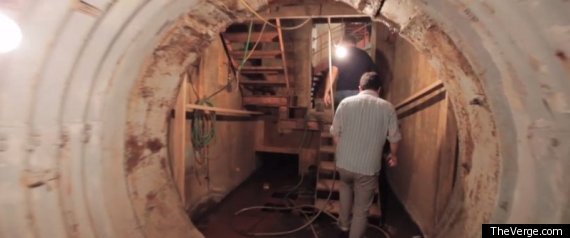The chief rule of real estate is supply and demand: the less supply, the greater the demand.
And with the clock ticking down to Dec. 21, 2012, the alleged last day of the Mayan calendar, some folks are trying to prepare for a worst-case scenario by getting decked out for doomsday with a shelter.
For some, that means turning to people like Ed Peden, a former school teacher in Troy, Kan., who not only lives in a Cold War bunker built in 1960 for $3.3 million, but also brokers similar properties for people who believe the end of the world is nigh.
Peden doesn't look like the stereotypical survivalist, a fact he freely admits.
"We're kind of peaceniks," he told TheVerge.com. "It's kind of strange to be living in what was a weapon of mass destruction. We see it as a transformational symbol."
Peden has sold 55 similar properties in the last 17 years and compares them to the old castles in medieval times.
"Some of these missile sites are some of the strongest structures ever built on the planet," he said.
But those old-school bomb shelters, which were decommissioned as part of treaties with the Soviet Union and sold for pennies on the dollar, are a finite item and, as such, are now attracting new interest.
"Our email and telephone have been busier than usual, because people are seeking the strength of a hardened underground structure," he said. "There's a lot of interest in these properties, but with the financial climate, banks are very tight, loans are next to impossible on these unique kind of structures, and there's more interest than there's actual buying. And these kind of properties are becoming a game for the wealthy."
The typical customer -- although Peden stresses there is no such thing -- are real estate investors, companies looking for secure data sources and the new breed of survivalists that call themselves "preppers."
On the other hand, many of these bunkers require a bit of refurbishing, more than some people want to do.
Dan Hotes is a commercial real estate broker based in Seattle and San Diego who specializes in the resale of Cold War-era missile bases and communication bunkers -- specifically, "those designed to withstand the effects of a nearby nuclear detonation." Hotes said that while missile silos are safe, they lack a little hominess.
"[The silos] are deep holes in the ground," Hotes told TheVerge.com. "I wouldn't want to be down in one of those. I would never do that."
However, for the right person, he has a Titan 1 missile base at the former Larson Air Force Base in Grant County, Wash., that he’s trying to unload for only $4 million.
For people who don't want to do the dirty work of refurbishing a doomsday shelter, there is Robert Vicino, an entrepreneur in Del Mar, Calif., who is building a series of planned underground communities like Terravivos, a cross between a time share and a bomb shelter, where people pay about $50,000 per adult and $25,000 per child (pets are free).
For the money, each owner gets an underground unit capable of withstanding massive earthquakes, flooding, radiation or biological attacks for an entire year, along with food, clothing and a medical facility.
Although 2012 is providing the impetus for some customers, Vicino is thinking past the Dec. 21 dooms-date.
"There are lots of people with 2012 concerns," he told AOL News. "I'm not a believer in it, but I am sure that sometime in our lifetimes, or our children's lifetimes, or our grandchildren's, there will be some disaster that happens that requires people to seek shelter."

The shelters are based on a spoke-and-hub complex, with 10 radiating wings surrounding a two-story central dome. The shelters will be 35 to 40 feet below the surface ("Radiation only goes 10 feet below the surface," he said) and will have a population density of one person per 100 square feet of floor area, twice as much as what is recommended by the Federal Emergency Management Agency (FEMA).
Vicino said he has sold more than half of the spaces available for the first shelter, which will be built near Barstow, Calif., a high desert community near Los Angeles and San Diego.
"We're actually retrofitting an existing shelter -- an existing Cold War-era government bunker that is in perfect condition," Vicino said, adding that it is only 13,000 square feet, so there is space for only 132 people.
So far, 30 percent are people in the medical field, such as doctors, nurses, psychologists and emergency technicians. Another 30 percent are people in law enforcement or the military.
"These people see disasters every day," he said.
Although 2012 is bringing media attention to the doomsday shelter industry, people like David South, CEO and president of Monolithic Dome Institute, a company that sells do-it-yourself doomsday domes, say that he refuses to use that to strike fear into the hearts of customers.
Of course, he's been selling his homes for 35 years and, last time he checked, the world was around.
"If we live long enough, we learn that we don't know what will happen tomorrow," he told The Huffington Post in August, adding that it doesn't hurt to have a plan.
South says his domes cost as much as any custom home and recommends that any person thinking about buying a new or old doomsday shelter write down what they want the home to do.
"Do you want it to protect you? Well, who or what do you want protection from? What do you expect it to do?" he asked rhetorically. "If you're worried most about nuclear fallout, you'll have to bury it five feet underground. On the other hand, if you fear tornadoes, put it on top of your property because those really only happen once every 40 years."
And, of course, the end of the world only happens once.
